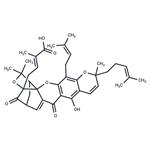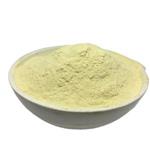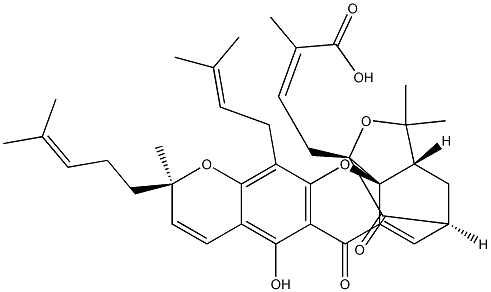- Gambogic Acid
-

- $33.00 / 2mg
-
2024-11-19
- CAS:2752-65-0
- Min. Order:
- Purity: 98.67%
- Supply Ability: 10g
- Gambogic acid
-

- $0.00 / 20mg
-
2023-02-24
- CAS:2752-65-0
- Min. Order: 5mg
- Purity: ≥98%(HPLC)
- Supply Ability: 10 g
- cambogicacid
-

- $90.00 / 1KG
-
2023-02-13
- CAS:2752-65-0
- Min. Order: 1KG
- Purity: 99%
- Supply Ability: 100mt
|
| | GAMBOGIC ACID Basic information |
| Product Name: | GAMBOGIC ACID | | Synonyms: | GaMbogic aci;BETA-GUTTIFERIN;BETA-GUTTILACTONE;GAMBOGIC ACID;GUTTATIC ACID;β-Guttilactone;2-Butenoic acid, 2-methyl-4-[(1R,3aS,5S,11R,14aS)-3a,4,5,7-tetrahydro-8-hydroxy-3,3,11-trimethyl-13-(3-methyl-2-buten-1-yl)-11-(4-methyl-3-penten-1-yl)-7,15-dioxo-1,5-methano-1H,3H,11H-furo[3,4-g]pyrano[3,2-b]xanthen-1-yl]-, (2Z)-;1,5-Methano-1H,3H,11H-furo(3,4-g)pyrano(3,2-b)xanthene-1-crotonic acid | | CAS: | 2752-65-0 | | MF: | C38H44O8 | | MW: | 628.75 | | EINECS: | | | Product Categories: | Inhibitors;chemical reagent;pharmaceutical intermediate;phytochemical;reference standards from Chinese medicinal herbs (TCM).;standardized herbal extract | | Mol File: | 2752-65-0.mol |  |
| | GAMBOGIC ACID Chemical Properties |
| Melting point | 88.5°C | | Boiling point | 586.06°C (rough estimate) | | alpha | D20 -685° (methanol) | | density | 1.1057 (rough estimate) | | refractive index | 1.5290 (estimate) | | storage temp. | -20°C | | solubility | DMSO: ≥10mg/mL | | form | powder | | pka | 4.58±0.36(Predicted) | | color | yellow to orange | | Stability: | Stable for 1 year as supplied. Solutions in DMSO or ethanol may be stored at -20°C for up to 1 month. | | InChIKey | GEZHEQNLKAOMCA-XKZIYDEJSA-N | | LogP | 6.490 (est) |
| Hazard Codes | T | | Risk Statements | 25-36/37/38 | | Safety Statements | 26-45 | | RIDADR | UN 2811 6.1 / PGIII | | WGK Germany | 1 | | RTECS | PB9268200 | | HS Code | 29189900 | | Toxicity | LD50 unreported in mammal (species unspecified): 55mg/kg |
| | GAMBOGIC ACID Usage And Synthesis |
| Description | Gambogic acid (2752-65-0) induces apoptosis in a variety of cell lines acting as an antagonist of Bcl-2 family proteins (IC50 < 1 mM)1, however additional targets may contribute to its cytotoxicity. It suppresses cancer invasion and migration by inhibiting TGFb1-induced epithelial-to-mesenchymal transition.2 Potentiates the chemosensitivity of cancer cells to other agents.3 Down-regulates surviving, reversing docetaxel resistance in cancer cells.4 | | Uses | antiinflammatory, cytotoxic, inhibits HeLa cells in vitro; | | Definition | ChEBI: A natural product found in Garcinia hanburyi. | | General Description | This substance is a primary reference substance with assigned absolute purity (considering chromatographic purity, water, residual solvents, inorganic impurities). The exact value can be found on the certificate. Produced by PhytoLab GmbH & Co. KG | | Biological Activity | Natural product isolated from the Garcinia hanburyi tree. Induces apoptosis in several tumor cell lines including T47D cells. Activates caspases with an EC 50 value of 0.78-1.64 μ M and competitively inhibits antiapoptotic Bcl-2 family proteins (IC 50 values are 1.47, 1.21, 2.02, 0.66, 1.06 and 0.79 μ M for Bcl-XL, Bcl-2, Bcl-W, Bcl-B, Bfl-1 and Mcl-1 respectively). Also blocks K IR 2.1 channels (EC 50 ≤ 100 nM). | | Biochem/physiol Actions | Gambogic acid acts as a caspase activator and apoptosis inducer, which causes an irreversible arrest in the G2/M phase of the cell cycle. | | Anticancer Research | Gambogic acid is a xanthonoid, also known as kokum that is a resin from Garciniaindica, that can inhibit the proliferation of human breast, hepatoma, lung, and gastriccarcinoma cells. It is also an apoptotic inducer and inhibits telomerase and theexpression of telomerase reverse transcriptase mRNA and its promoter. It also suppressesCDK7-mediated CDC2/p34 phosphorylation, downregulates Bcl-2, andinteracts with c-myc. By interacting with transferrin receptors, it mediates apoptosisof cancer cells. It inhibits NF-κB pathway. In vivo and in vitro experiments determinedits potential to inhibit angiogenesis and VGEF-2 receptor, and thus it inhibitshuman endothelial cell growth, invasion, and migration, microvessel growth, andtube formation (Zhang et al. 2004; Pandey et al. 2007; Aggarwal et al. 2008).
GA, extract from Garcinia hanburyi, the most important active constituent of gamboge,inhibits the heat shock protein (Hsp90) (Zhang 2010). Hsp90 is the majorprotein in tumour regeneration as well as cell signalling, and its inhibition results ininduction of ER stress, thereby activating UPR target genes and ER stress sensorswhich further cause cell death (Lamoureux et al. 2014). Severe or sustained ERstress increases CHOP expression and stimulates IRE1α apoptotic signalling, ATF6and PERK. CHOP being the major regulator of Bcl2, Bim and DR5 leads to cellularapoptosis preventing tumour progression (Krajarng et al. 2015). | | References | 1) Zhai et al. (2008), Gambogic acid is an antagonist of antiapoptotic Bcl-2 family proteins; Mol. Cancer Ther. 7 1639
2) Zhao et al. (2017), Gambogic acid suppresses cancer invasion and migration by inhibiting TGFβ1-induced epithelial-to-mesenchymal transition; Oncotarget 8 27120
3) Wei et al. (2017), Gambogic acid potentiates the chemosensitivity of colorectal cancer cells to 5-fluorouracil by inhibiting proliferation and inducing apoptosis; Exp. Ther. Med. 13 662
4) Wang et al. (2008), Gambogic acid, a potent inhibitor of surviving, reverses docetaxel resistance in gastric cancer cells; Cancer Lett. 262 214 |
| | GAMBOGIC ACID Preparation Products And Raw materials |
|